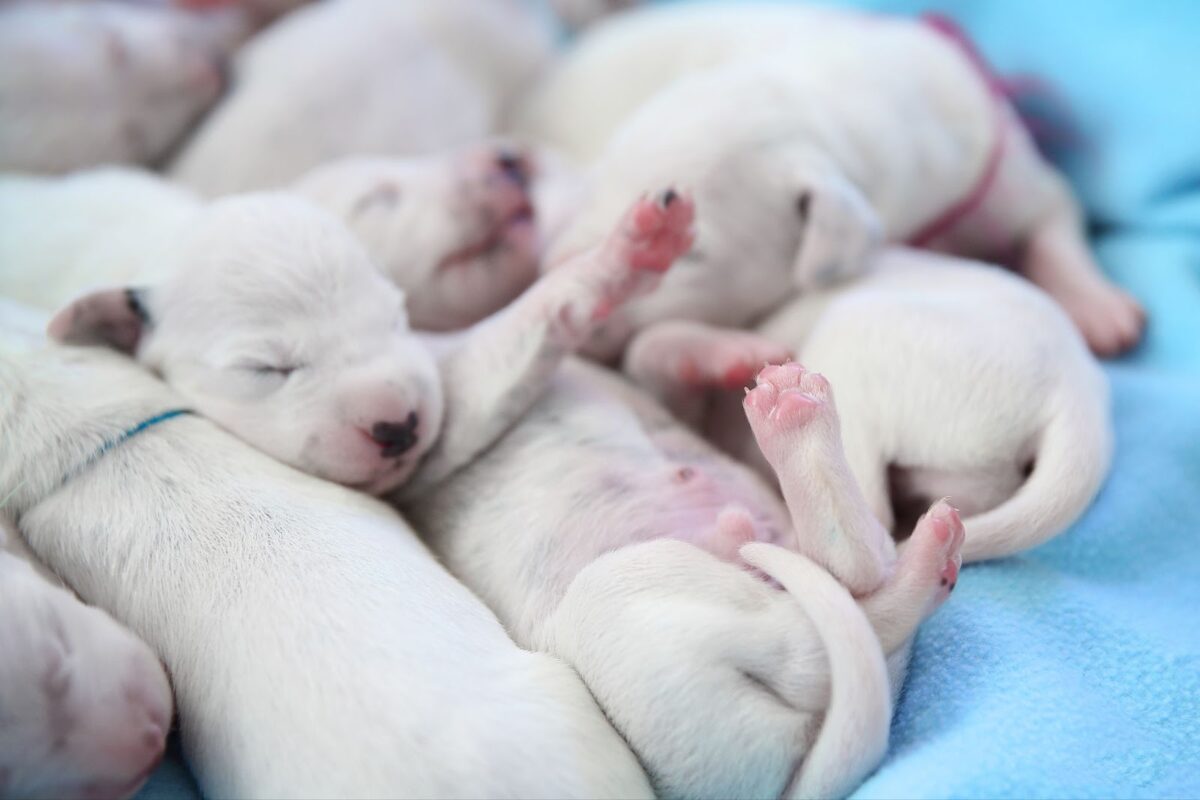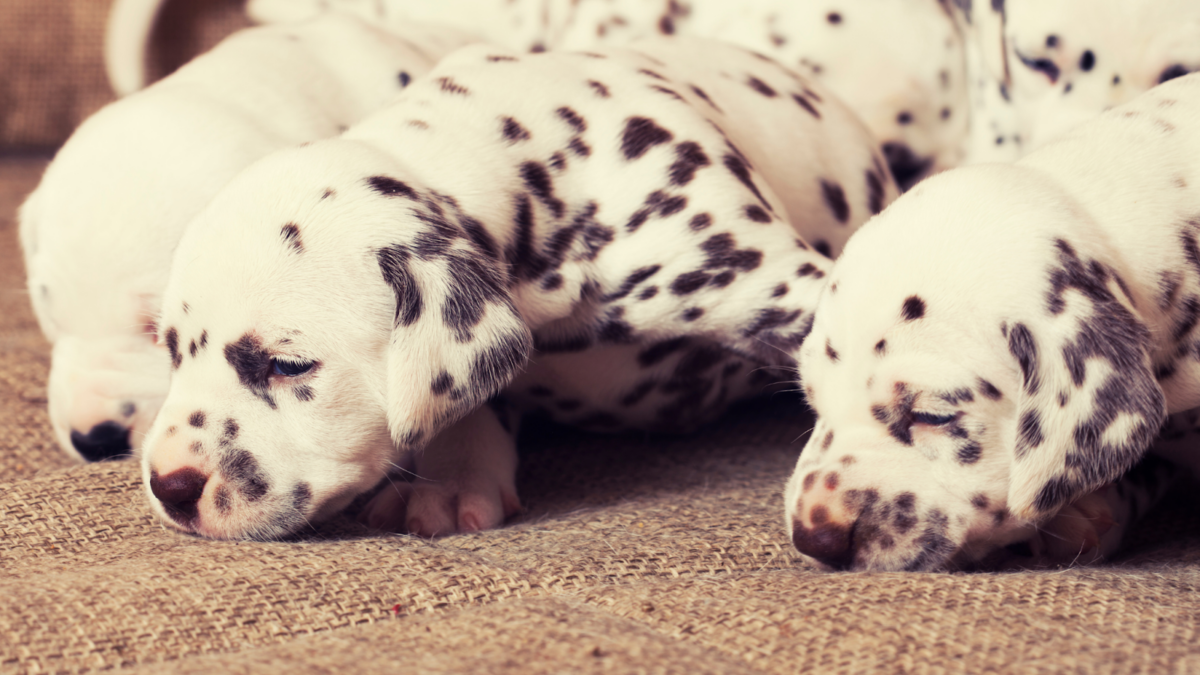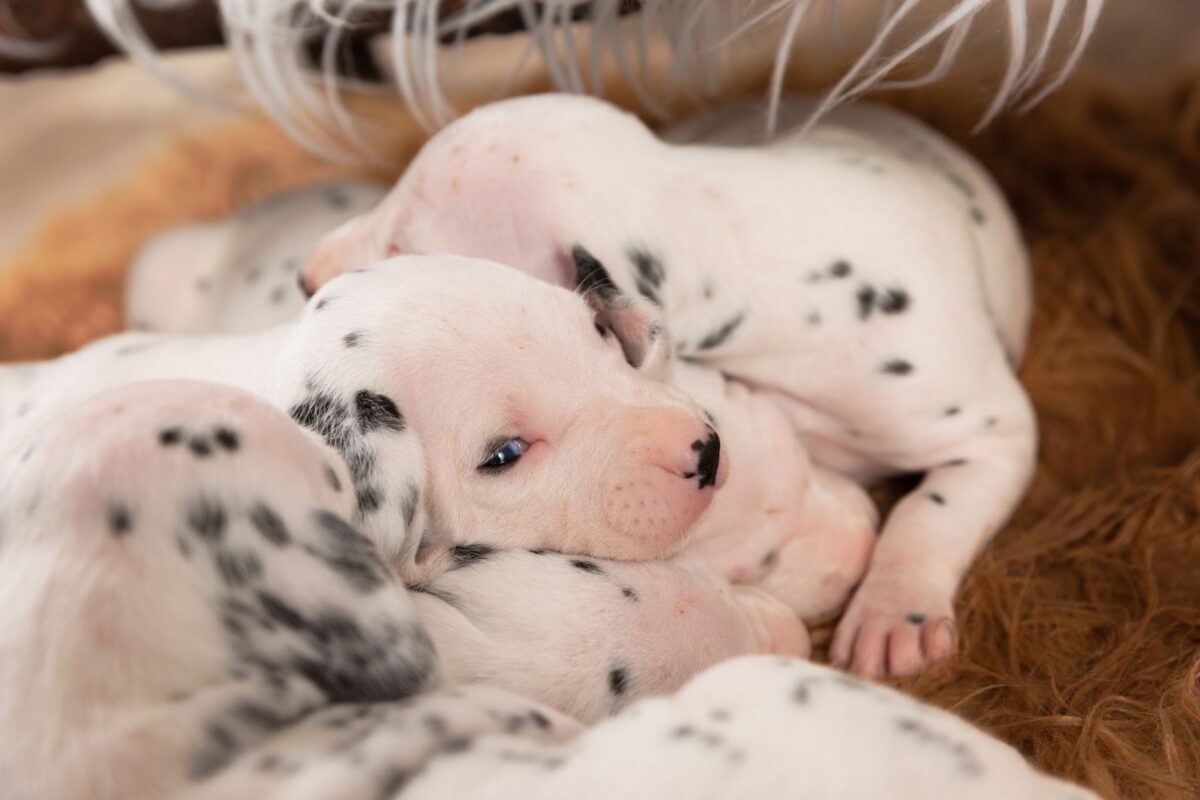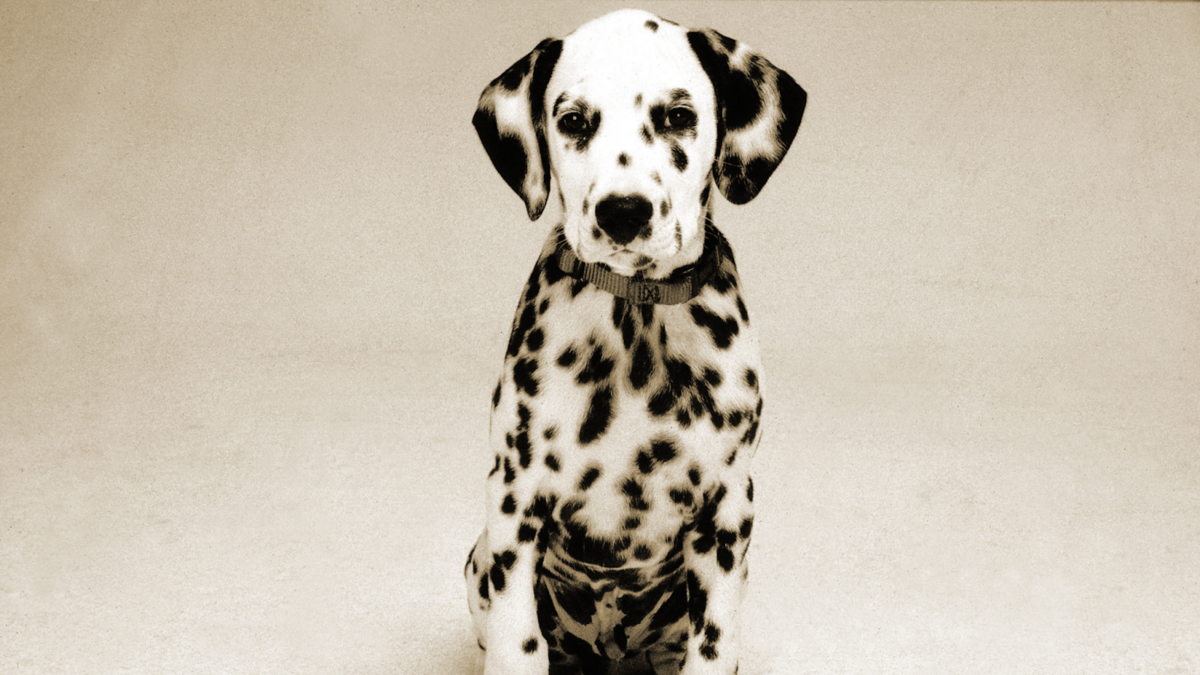Dalmatian puppies are born with a pristine white coat that serves as a blank canvas for their iconic spots. The spots are a defining characteristic of the breed and are eagerly anticipated by Dalmatian enthusiasts. These spots, a result of selective breeding for a unique appearance, are not present at birth. Instead, they begin to appear as the puppies grow. This coloration process is a fascinating element of the breed’s development and genetics.
Understanding when and how Dalmatian puppies develop spots is essential for breeders and owners alike. This article will draw upon expert sources such as Dr. Monika Burns, whose insights in “Genetics of The Dog: The Basis of Successful Breeding” provide a deeper comprehension of the breed’s unique coat patterns. From pinpointing the age at which spots emerge to discussing the implications for health and breed standards, we will explore the journey of a Dalmatian’s spots from puppyhood to maturity.
So, When Do Dalmatians Get Their Spots?
Dalmatian puppies are born pure white. Between 10 to 14 days, the first spots begin to emerge. Genetics play a crucial role in not just the color of the spots, but also their eventual distribution across the puppy’s body. It’s pretty fascinating because even though you can’t see them, the number of spots a Dalmatian will have is already predetermined genetically.
As they grow, the spots will become more prominent and darker, but the total count won’t change – they’re set from the get-go. These spots are a result of a specific gene, and the process of how they appear and spread over the coat is complex and governed by the pup’s individual genetic map.
- Birth: Puppies are white.
- 10-14 days: Spots start to show.
- Genetics: Dictate number and pattern of spots, as well as the color.
The pattern and number of spots not only add to the unique beauty of each Dalmatian but also make every single one of them one of a kind. Their spots are a little like fingerprints, with no two Dalmatians sporting the same pattern.
Dalmatian puppies start the show with a blank white coat and begin to develop their trademark spots between 10 to 14 days after birth, the number and pattern of which are set by their genes.
Understanding Dalmatian Spots

Deciphering the mysteries behind Dalmatian spots reveals a fascinating interplay between genetics and development. From snowy white at birth to their distinctive speckled fur, these dogs follow a unique path in their early life stages.
Coat Color Development
Dalmatian puppies start life with pure white coats. Their trademark spots are not visible at first but begin to emerge between 10 to 14 days after birth. A Dalmatian’s spots are a part of the dog’s skin pigment and are predetermined, although the exact process of how they develop on the coat is an intricate genetic dance.
Genetics Behind the Spots
The spots are the result of specific genetic interactions, particularly involving the Piebald locus, which is responsible for the white base of the coat. Further genetic influence comes from Ticking and Flecking loci, which introduce the black or liver-colored spots against the white background. This intricate genetic play also includes a TYRP1 gene variant, which determines whether the spots will be black or liver, based on the microsatellite marker FH2319 on chromosome 11.
Spot Patterns and Variabilities
As for the individuality in spot patterns, each Dalmatian carries a distinct set of spots that can serve as an identifier, similar to a fingerprint. While the base color of spots is either black or liver, due to genetic variations, the size and number of the spots can vary greatly among individual dogs, adhering to the breed standards. Despite these variations, the spots typically don’t change in number as the dog matures, although additional smaller flecks may appear over time.
Dalmatian Puppies From Birth to Spots

Dalmatian puppies are renowned for their distinctive coats which develop in a unique manner from birth.
Newborn Appearance
When Dalmatian puppies are born, they are almost entirely pure white. This initial lack of spots is typical for the breed, and the newborn pups’ skin doesn’t show the iconic spots they are famous for at this stage. They are small in size, and their eyes remain closed, relying entirely on their mother.
Spot Appearance Timeline

Within a week to two weeks, they start to develop their first spots. The spots emerge due to a genetic trait where flecking loci become visible on the puppies’ coat. As they reach the age of about four weeks, the spots become more pronounced and distributed across their bodies. It’s during this period of growth that the Dalmatian puppies begin to show the traits they are so well-loved for.
Spots and Puppy Growth
As the Dalmatian puppies continue to grow, both in age and size, the number of their spots increases. Typically, by the age of six months, their spots are well defined, although they continue to develop until the dog is around one year old. As they mature, feeding transitions and puppy growth are essential considerations when can puppies start eating food and drinking water. It’s important for owners to facilitate their iconic spots’ development with appropriate nutrition and care.
As the puppies grow over the next few months, their spots become more pronounced and distinct. By the time they’re around three to four months old, their spots are quite noticeable, giving them that classic Dalmatian look. However, the development of their coat doesn’t stop there. The spots continue to change and develop as the puppy matures. They might become darker or even change in size slightly.
By the time Dalmatians reach adulthood, usually around 18 months, their spots have fully developed. However, it’s interesting to note that even as adults, Dalmatians can occasionally develop new spots. The final pattern is a result of a complex interplay of genetics, making each Dalmatian’s coat uniquely their own.
Health and Care for Spotted Coats

Dalmatian puppies are known for their distinctive, well-defined spots, which require specific care to maintain a healthy coat. Proper grooming, regular check-ups for common health issues, and attention to potential deafness are all crucial aspects of their care.
Grooming and Shedding
Dalmatians have a sleek, short coat that is known for shedding throughout the year. Regular brushing at least once a week helps to remove dead skin cells and minimize shedding. Using a rubber grooming mitt or a bristle brush is effective in catching the loose hairs. Additionally, they need occasional baths to keep their coats clean; however, it’s important to use a mild dog shampoo to avoid irritating the skin.
Common Health Issues
When caring for a Dalmatian’s spotted coat, it’s important to monitor for signs of skin issues, such as itching or redness, which could indicate allergies or other problems. Owners should be aware of the breed’s predisposition to certain urinary issues due to their unique urinary system. Maintaining access to clean water and providing ample opportunity for exercise can help manage this risk.
Deafness is another concern in Dalmatians, especially those with pure white coats who may be at higher risk. A veterinarian can conduct a BAER test (Brainstem Auditory Evoked Response) to assess hearing. Dalmatian owners should check their dog’s ears regularly for wax buildup or infection, which can contribute to hearing issues if not addressed promptly.
To support overall health, Dalmatian owners should work closely with their veterinarian to establish a tailored care routine, including diet, exercise, and regular check-ups. With the right care, these distinctive dogs can lead a healthy and happy life.
Breeding and Standards of Dalmatians

When it comes to Dalmatians, breeding practices largely focus on meeting the breed standards, especially the distinct coat color patterns these dogs are famous for. These standards do not only dictate the appearance but also have a significant impact on the breed’s popularity.
Color Standards in Breeding
According to the American Kennel Club (AKC), Dalmatians should have a white coat with either black spots or liver-colored spots. The spots should be well-defined, and they typically start to develop about three weeks after birth. Breed standards discourage spots that blend together or are too large, known in the community as “ticking.”
Breeding standards for Dalmatians specify that color is a critical consideration. Breeders often strive to produce puppies with the signature spots that are evenly distributed without patches, which can be seen as a deviation from the pure breed ideal. This specific coat pattern is what many associate with the classic look of the Dalmatian.
Influence of Breed Standards on Popularity
Standards set by dog registries have shaped the public’s perception of what a Dalmatian should look like. This has influenced the breed’s popularity, with those conforming to the ideal pattern and coloration often being more sought after for show and as pets. The piebald gene is responsible for the base white coat and, in combination with other genes, the distinctive spots. A Dalmatian’s adherence to the breed standard can significantly impact its success in the show ring, and by extension, its popularity among potential dog owners and breeders.
Dalmatians in Society
Dalmatians have a spotted presence in both pop culture and various roles within society. Known for their unique spotted skin, these dogs balance an appearance that’s both muscular and elegant.
Pop Culture Influence
Dalmatians shot to fame with the release of “101 Dalmatians,” capturing hearts with their playful nature and distinct patterns. This Disney classic significantly boosted the popularity of the breed, making them lovable icons in households worldwide. The movie portrays these spotted companions as loyal and loving family pets, contributing to their esteemed status in pop culture.
Dalmatian Roles and Jobs
Historically known as watchdogs and carriage dogs, Dalmatians have a strong tradition of serving alongside firefighters. Their muscular build and high energy made them ideal for running ahead of fire carriages to clear a path. Today, they still hold a ceremonial position in many fire stations. Dalmatians’ blend of an aloof demeanor with a loyal personality also makes them suitable for modern roles such as therapy and assistance dogs.
Frequently Asked Questions (FAQs)
In this section, you’ll find answers to some common curiosities about the Dalmatian’s unique spots, from when they first appear to the number one can expect on a typical Dalmatian coat.
At what stage do spots appear on Dalmatian puppies?
Dalmatian puppies are born with mostly white coats, and their spots start to appear within 10 to 14 days after birth. However, they continue to develop and become more prominent as the puppies grow.
Is it true that all Dalmatians are deaf from birth?
Not all Dalmatians are deaf from birth; however, the breed has a higher incidence of hearing loss. Around 15 to 30 percent of Dalmatian puppies are affected by some degree of deafness, which is usually identified within the first few weeks of life.
How does the number of spots on a Dalmatian change as they grow?
The number of spots on a Dalmatian doesn’t necessarily change as they grow, but the spots can become darker and more defined. The size of the spots may also increase slightly, giving the appearance of a larger number of spots.
What’s the typical number of spots a Dalmatian has?
A typical Dalmatian has anywhere from 25 to 100 spots, of varying sizes. The spots are usually well-defined and spaced over the body.
Can a Dalmatian puppy be spotless when it’s born?
Yes, a Dalmatian puppy can be born completely spotless. The spots develop later on as the puppy grows, often starting to emerge at around two weeks of age.
Why are Dalmatians known for their distinctive spotted coats?
Dalmatians are known for their distinctive spotted coats because of a genetic trait that causes pigmented spots to form on their coats. This trait is a breed-specific characteristic that has been selected and preserved over many generations.
Final Thoughts
When curious minds ask about Dalmatian puppies and their spots, they discover that these iconic spots aren’t present at birth. Instead, puppies are born with pure white coats. Their spots start to emerge after about 10 to 14 days, and it is common for the spots to continue developing and changing in size and darkness as they grow. By the time a Dalmatian is around one month old, most of their spots are visible, although they can still develop new spots for several months.
An interesting tidbit is that each Dalmatian’s spots are unique, like fingerprints. No two dogs have the same pattern. For those who have a keen interest in the breed or are considering adding a Dalmatian to their family, it’s essential to remember that proper care and nutrition are key to a puppy’s development, including that of their spots. Furthermore, the full pattern of spots is generally present by the time the puppy is four months old.
It’s important to share that love for a Dalmatian should not just be for their spots. These are energetic and intelligent dogs needing regular exercise, mental stimulation, and a lot of affection. They make wonderful pets with the right family dynamic. And while those spots might initially draw attention to the breed, it’s their loyal and loving nature that truly makes them a beloved part of any home.
- Santiago, P.A., Magalhães, R.F.A., Abreu, T.M., Almeida, A.P. and Oliveira, C.D.A., 2020. Genetic evaluation of the coat of dogs of the Dalmatian breed. Ciência Animal, 30(Suppl. 1), pp.33-41.
- Herzog, H., 2006. Forty-two thousand and one Dalmatians: Fads, social contagion, and dog breed popularity. Society & animals, 14(4), pp.383-397.
- Gazzano, A., Mariti, C., Notari, L., Sighieri, C. and McBride, E.A., 2008. Effects of early gentling and early environment on emotional development of puppies. Applied Animal Behaviour Science, 110(3-4), pp.294-304.
- Lawler, D.F., 2008. Neonatal and pediatric care of the puppy and kitten. Theriogenology, 70(3), pp.384-392.

